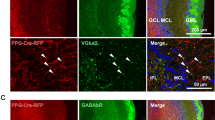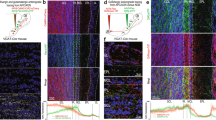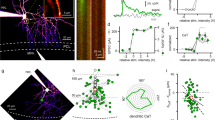Abstract
Microcircuits composed of principal neuron and interneuron dendrites have an important role in shaping the representation of sensory information in the olfactory bulb. Here we establish the physiological features governing synaptic signaling in dendrodendritic microcircuits of olfactory bulb glomeruli. We show that dendritic γ-aminobutyric acid (GABA) release from periglomerular neurons mediates inhibition of principal tufted cells, retrograde inhibition of sensory input and lateral signaling onto neighboring periglomerular cells. We find that L-type dendritic Ca2+ spikes in periglomerular cells underlie dendrodendritic transmission by depolarizing periglomerular dendrites and activating P/Q type channels that trigger GABA release. Ca2+ spikes in periglomerular cells are evoked by powerful excitatory inputs from a single principal cell, and glutamate release from the dendrites of single principal neurons activates a large ensemble of periglomerular cells.
This is a preview of subscription content, access via your institution
Access options
Subscribe to this journal
Receive 12 print issues and online access
$209.00 per year
only $17.42 per issue
Buy this article
- Purchase on Springer Link
- Instant access to full article PDF
Prices may be subject to local taxes which are calculated during checkout








Similar content being viewed by others
References
White, E.L. Synaptic organization of the mammalian olfactory glomerulus: new findings including an intraspecific variation. Brain Res. 60, 299–313 (1973).
White, E.L. Synaptic organization in the olfactory glomerulus of the mouse. Brain Res. 37, 69–80 (1972).
Pinching, A.J. & Powell, T.P. The neuropil of the glomeruli of the olfactory bulb. J. Cell Sci. 9, 347–377 (1971).
Shepherd, G.M. & Greer, C.A. Olfactory bulb. in The Synaptic Organization of the Brain (ed. Shepherd, G.M.) 159–203 (Oxford Univ. Press, Oxford, 1998).
Brennan, P.A. & Keverne, E.B. Neural mechanisms of mammalian olfactory learning. Prog. Neurobiol. 51, 457–481 (1997).
Yokoi, M., Mori, K. & Nakanishi, S. Refinement of odor molecule tuning by dendrodendritic synaptic inhibition in the olfactory bulb. Proc. Natl Acad. Sci. USA 92, 3371–3375 (1995).
Spors, H. & Grinvald, A. Spatio-temporal dynamics of odor representations in the mammalian olfactory bulb. Neuron 34, 301–315 (2002).
Cang, J. & Isaacson, J.S. In vivo whole-cell recording of odor-evoked synaptic transmission in the rat olfactory bulb. J. Neurosci. 23, 4108–4116 (2003).
Margrie, T.W. & Schaefer, A.T. Theta oscillation coupled spike latencies yield computational vigour in a mammalian sensory system. J. Physiol. (Lond.) 546, 363–374 (2003).
Isaacson, J.S. & Strowbridge, B.W. Olfactory reciprocal synapses: dendritic signaling in the CNS. Neuron 20, 749–761 (1998).
Chen, W.R., Xiong, W. & Shepherd, G.M. Analysis of relations between NMDA receptors and GABA release at olfactory bulb reciprocal synapses. Neuron 25, 625–633 (2000).
Schoppa, N.E., Kinzie, J.M., Sahara, Y., Segerson, T.P. & Westbrook, G.L. Dendrodendritic inhibition in the olfactory bulb is driven by NMDA receptors. J. Neurosci. 18, 6790–6802 (1998).
Halabisky, B., Friedman, D., Radojicic, M. & Strowbridge, B.W. Calcium influx through NMDA receptors directly evokes GABA release in olfactory bulb granule cells. J. Neurosci. 20, 5124–5134 (2000).
Isaacson, J.S. Mechanisms governing dendritic γ-aminobutyric acid (GABA) release in the rat olfactory bulb. Proc. Natl Acad. Sci. USA 98, 337–342 (2001).
Egger, V., Svoboda, K. & Mainen, Z.F. Mechanisms of lateral inhibition in the olfactory bulb: efficiency and modulation of spike-evoked calcium influx into granule cells. J. Neurosci. 23, 7551–7558 (2003).
Price, J.L. & Powell, T.P. The synaptology of the granule cells of the olfactory bulb. J. Cell Sci. 7, 125–155 (1970).
Christie, J.M., Schoppa, N.E. & Westbrook, G.L. Tufted cell dendrodendritic inhibition in the olfactory bulb is dependent on NMDA receptor activity. J. Neurophysiol. 85, 169–173 (2001).
Aroniadou-Anderjaska, V., Zhou, F.M., Priest, C.A., Ennis, M. & Shipley, M.T. Tonic and synaptically evoked presynaptic inhibition of sensory input to the rat olfactory bulb via GABAB heteroreceptors. J. Neurophysiol. 84, 1194–1203 (2000).
Murphy, G.J., Glickfeld, L.L., Balsen, Z. & Isaacson, J.S. Sensory neuron signaling to the brain: properties of transmitter release from olfactory nerve terminals. J. Neurosci. 24, 3023–3030 (2004).
Smith, T.C. & Jahr, C.E. Self-inhibition of olfactory bulb neurons. Nat. Neurosci. 5, 760–766 (2002).
Salin, P.A. & Prince, D.A. Spontaneous GABAA receptor-mediated inhibitory currents in adult rat somatosensory cortex. J. Neurophysiol. 75, 1573–1588 (1996).
Hausser, M. & Roth, A. Estimating the time course of the excitatory synaptic conductance in neocortical pyramidal cells using a novel voltage jump method. J. Neurosci. 17, 7606–7625 (1997).
Pearce, R.A. Physiological evidence for two distinct GABAA responses in rat hippocampus. Neuron 10, 189–200 (1993).
Perez-Reyes, E. Molecular physiology of low-voltage-activated t-type calcium channels. Physiol. Rev. 83, 117–161 (2003).
Holderith, N.B., Shigemoto, R. & Nusser, Z. Cell type-dependent expression of HCN1 in the main olfactory bulb. Eur. J. Neurosci. 18, 344–354 (2003).
Cadetti, L. & Belluzzi, O. Hyperpolarisation-activated current in glomerular cells of the rat olfactory bulb. Neuroreport 12, 3117–3120 (2001).
Regehr, W., Kehoe, J.S., Ascher, P. & Armstrong, C. Synaptically triggered action potentials in dendrites. Neuron 11, 145–151 (1993).
Golding, N.L. & Spruston, N. Dendritic sodium spikes are variable triggers of axonal action potentials in hippocampal CA1 pyramidal neurons. Neuron 21, 1189–1200 (1998).
Kim, H.G. & Connors, B.W. Apical dendrites of the neocortex: correlation between sodium- and calcium-dependent spiking and pyramidal cell morphology. J. Neurosci. 13, 5301–5311 (1993).
Schwindt, P. & Crill, W. Equivalence of amplified current flowing from dendrite to soma measured by alteration of repetitive firing and by voltage clamp in layer 5 pyramidal neurons. J. Neurophysiol. 76, 3731–3739 (1996).
Pennartz, C.M., de Jeu, M.T., Bos, N.P., Schaap, J. & Geurtsen, A.M. Diurnal modulation of pacemaker potentials and calcium current in the mammalian circadian clock. Nature 416, 286–290 (2002).
Avery, R.B. & Johnston, D. Multiple channel types contribute to the low-voltage-activated calcium current in hippocampal CA3 pyramidal neurons. J. Neurosci. 16, 5567–5582 (1996).
Magee, J.C., Avery, R.B., Christie, B.R. & Johnston, D. Dihydropyridine-sensitive, voltage-gated Ca2+ channels contribute to the resting intracellular Ca2+ concentration of hippocampal CA1 pyramidal neurons. J. Neurophysiol. 76, 3460–3470 (1996).
Power, J.M. & Sah, P. Intracellular calcium store filling by an L-type calcium current in the basolateral amygdala at subthreshold membrane potentials. J. Physiol. 562, 439–453 (2005).
Salin, P.A., Lledo, P.M., Vincent, J.D. & Charpak, S. Dendritic glutamate autoreceptors modulate signal processing in rat mitral cells. J. Neurophysiol. 85, 1275–1282 (2001).
Friedman, D. & Strowbridge, B.W. Functional role of NMDA autoreceptors in olfactory mitral cells. J. Neurophysiol. 84, 39–50 (2000).
Isaacson, J.S. Glutamate spillover mediates excitatory transmission in the rat olfactory bulb. Neuron 23, 377–384 (1999).
Macrides, F. & Chorover, S.L. Olfactory bulb units: activity correlated with inhalation cycles and odor quality. Science 175, 84–87 (1972).
Hayar, A., Karnup, S., Shipley, M.T. & Ennis, M. Olfactory bulb glomeruli: external tufted cells intrinsically burst at theta frequency and are entrained by patterned olfactory input. J. Neurosci. 24, 1190–1199 (2004).
Schoppa, N.E. & Westbrook, G.L. Glomerulus-specific synchronization of mitral cells in the olfactory bulb. Neuron 31, 639–651 (2001).
Toida, K., Kosaka, K., Heizmann, C.W. & Kosaka, T. Chemically defined neuron groups and their subpopulations in the glomerular layer of the rat main olfactory bulb: III. Structural features of calbindin D28K-immunoreactive neurons. J. Comp. Neurol. 392, 179–198 (1998).
Kosaka, K., Toida, K., Aika, Y. & Kosaka, T. How simple is the organization of the olfactory glomerulus? The heterogeneity of so-called periglomerular cells. Neurosci. Res. 30, 101–110 (1998).
Aungst, J.L. et al. Centre-surround inhibition among olfactory bulb glomeruli. Nature 426, 623–629 (2003).
Stengel, W., Jainz, M. & Andreas, K. Different potencies of dihydropyridine derivatives in blocking T-type but not L-type Ca2+ channels in neuroblastoma-glioma hybrid cells. Eur. J. Pharmacol. 342, 339–345 (1998).
McQuiston, A.R. & Katz, L.C. Electrophysiology of interneurons in the glomerular layer of the rat olfactory bulb. J. Neurophysiol. 86, 1899–1907 (2001).
Lipscombe, D., Helton, T.D. & Xu, W. L-type calcium channels: the low down. J. Neurophysiol. 92, 2633–2641 (2004).
Xu, W. & Lipscombe, D. Neuronal CaV1.3α1 L-type channels activate at relatively hyperpolarized membrane potentials and are incompletely inhibited by dihydropyridines. J. Neurosci. 21, 5944–5951 (2001).
Puopolo, M. & Belluzzi, O. Functional heterogeneity of periglomerular cells in the rat olfactory bulb. Eur. J. Neurosci. 10, 1073–1083 (1998).
Hillman, D. et al. Localization of P-type calcium channels in the central nervous system. Proc. Natl Acad. Sci. USA 88, 7076–7080 (1991).
Schoppa, N.E. & Westbrook, G.L. Regulation of synaptic timing in the olfactory bulb by an A-type potassium current. Nat. Neurosci. 2, 1106–1113 (1999).
Acknowledgements
We thank M. Scanziani, P. Sah and K. Franks for helpful discussions. G.J.M. received support from an NRSA predoctoral fellowship (NIDCD; DC005679). J.S.I. received support from a McKnight Scholar Award, Klingenstein Award, Burroughs-Wellcome Career Award and the NIH (RO1 DC04682).
Author information
Authors and Affiliations
Corresponding author
Ethics declarations
Competing interests
The authors declare no competing financial interests.
Supplementary information
Supplementary Fig. 1
We quantified the impact of AP-evoked release from PG cells by measuring the probability that single APs evoked a response in postsynaptic neurons. (PDF 71 kb)
Supplementary Fig. 2
P/Q-type Ca2+ channels govern GABA release between periglomerular and tufted cells. (PDF 185 kb)
Supplementary Fig. 3
Kinetics of PG cell activation during DDI. (PDF 272 kb)
Rights and permissions
About this article
Cite this article
Murphy, G., Darcy, D. & Isaacson, J. Intraglomerular inhibition: signaling mechanisms of an olfactory microcircuit. Nat Neurosci 8, 354–364 (2005). https://doi.org/10.1038/nn1403
Received:
Accepted:
Published:
Issue Date:
DOI: https://doi.org/10.1038/nn1403
This article is cited by
-
Long-range GABAergic projections contribute to cortical feedback control of sensory processing
Nature Communications (2022)
-
The transcriptional coactivator and histone acetyltransferase CBP regulates neural precursor cell development and migration
Acta Neuropathologica Communications (2019)
-
Cortical Organization of Centrifugal Afferents to the Olfactory Bulb: Mono- and Trans-synaptic Tracing with Recombinant Neurotropic Viral Tracers
Neuroscience Bulletin (2019)
-
Sparsened neuronal activity in an optogenetically activated olfactory glomerulus
Scientific Reports (2018)
-
Comparative study of chemical neuroanatomy of the olfactory neuropil in mouse, honey bee, and human
Biological Cybernetics (2018)



